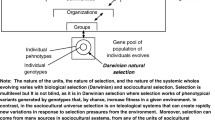Abstract
Part of Allen et al.’s criticism of Hamilton’s rule makes sense only if we are interested in social adaptation rather than merely social selection. Under the assumption that we are interested in casually modeling social adaptation, I illustrate how graphical causal models of social adaptation can be useful for predicting evolution by adaptation. I then argue for two consequences of this approach given some of the recent philosophical literature. I argue Birch’s claim that the proper way to understand Hamilton’s rule is as providing an organizational framework for causal models is incorrect. I provide an account of a causally adequate decomposition of evolutionary change due to social adaptation and show that my account is superior to Okasha’s.










Similar content being viewed by others
Notes
To obtain the rule in its familiar form of \(\varDelta A(Y)> 0 \Longleftrightarrow rb > c\), let \(r = \rho\), \(b = \beta _2\), and \(c = - \beta _1\). I prefer to use the notation that shows these are explicitly statistical parameters rather than the metaphorical and, to my mind, potentially confusing “cost” and “benefit” notation.
I thank an anonymous referee for making me clarify this point.
I thank an anonymous referee for asking me to clarify this point.
References
Allen B, Nowak M, Wilson E (2013) Limitations of inclusive fitness. PNAS 110:20,135–20,139
Birch J (2017) The philosophy of social evolution. Oxford University Press, Oxford
Crespi B, Bookstein F (1989) A path-analytic model for the measurement of selection on morphology. Evolution 43:18–28
Hamilton W (1964) The genetic evolution of social behavior. J Theor Biol 7:1–52
Malinsky D, Shpitser I, Richardson T (2019) A potential outcomes calculus for identifying conditional path-specific effects. In: Proceedings of the 22nd international conference on artificial intelligence and statistics (AISTATS)
Okasha S (2006) Evolution and the levels of selection. Oxford University Press, Oxford
Okasha S (2015) The relation between kin and multilevel selection: an approach using causal graphs. Br J Philos Sci 67:1–36
Pearl J (2000) Causality: models, reasoning, and inference. Cambridge University Press, Cambridge
Pearl J (2001) Direct and indirect effects. In: Breese J, Koller D (eds) Proceedings of the 17th conference on uncertainty in artificial intelligence (UAI-01). Morgan Kaufmann, Burlington, pp 411–420
Price G (1970) Selection and covariance. Nature 227:520–521
Robins J, Greenland S (1992) Identifiability and exchangeability for direct and indirect effects. Epidemiology 3:143–155
Robins J, Richardson T (2010) Alternative graphical causal models and the identification of direct effects. In: Shrout P (ed) Causality and psychopathology. Oxford University Press, Oxford, pp 103–158
Sober E (1984) The nature of selection. University of Chicago Press, Chicago
Sober E, Wilson D (1998) Unto others: the evolution and psychology of unselfish behavior. Harvard University Press, Cambridge
Wolf J, Brodie E III, Cheverud J, Moore A, Wade M (1998) Evolutionary consequences of indirect genetic effects. Trends Ecol Evol 13:64–69
Wright S (1934) The method of path coefficients. Ann Math Stat 5:161–215
Acknowledgements
I express my gratitude to Jonathan Birch, Valerie Racine, and an anonymous referee. The paper significantly improved due to their comments on previous drafts.
Author information
Authors and Affiliations
Corresponding author
Additional information
Publisher's Note
Springer Nature remains neutral with regard to jurisdictional claims in published maps and institutional affiliations.
Rights and permissions
About this article
Cite this article
Anderson, W. Graphical causal models of social adaptation and Hamilton’s rule. Biol Philos 34, 48 (2019). https://doi.org/10.1007/s10539-019-9703-1
Received:
Accepted:
Published:
DOI: https://doi.org/10.1007/s10539-019-9703-1




